Curiosity out of vacation
Almost all of April, there was no connection with Mars, so the satellites and rovers downloaded the program for a month and, blessing, entrusted themselves. There is no choice - once every two years it will be repeated until the transponder is placed in heliocentric orbit, but it will not be soon.
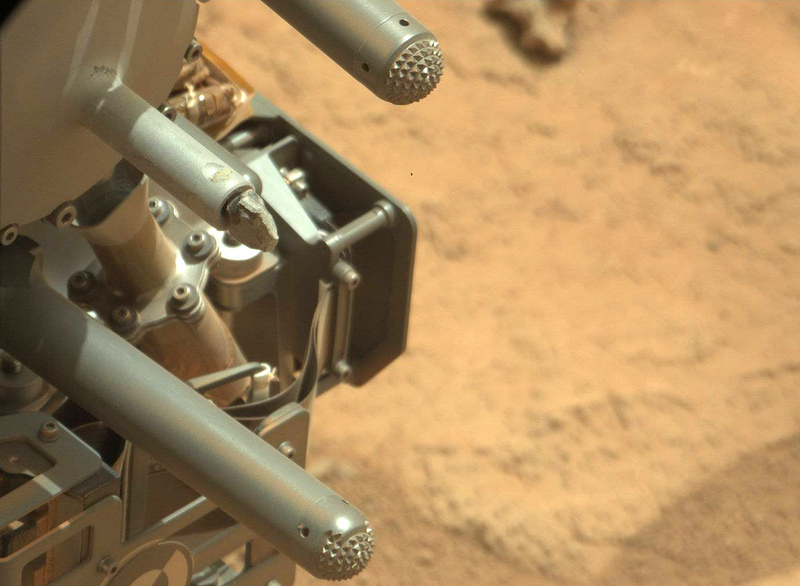
Curiosity barely recovered from damage to memory elements and survived a “brain transplant”, so its creators particularly worried about it. Veteran Opportunity experienced such “holidays” repeatedly, so for his team this has become almost a chore. At the same time, a few days before the end of the "vacation", Opportunity caught the mistake and went into standby mode, and immediately after the restoration of communication on Curiosity started a software update. But now both in the ranks and all in the work.
Back in March, before the solar overlap, an important event in the scientific world took place: the 44th Conference of the Moon and Planets. Although the subject covered almost the entire solar system, the whole event was held under the sign of Curiosity and Mars. More than 60 research teams dedicated their reports to the conference to the Curiosity results. Those who wish to plunge into the advanced front of planetary science offer to look into the conference theses .
At this event, scientists not only shared the scientific materials obtained by the rovers, but also revealed their future plans. Actually, Curiosity is planned to be returned to the route that it had been planned for before landing. But in the light of the new data that he discovered despite the early scientific program, his path now needs a more convincing basis.
')
I will remind a little. When Curiosity was landed on Mars, it was assumed that it would rush to Mount Eolid (Sharpe) because smectites were found at its foot from the satellite — clays that indicate a favorable climate that could contribute to the vital activity of the organisms. True, when landing, the rover slightly deviated from the intended route, so he found an intermediate target called Glenelg.

In Glenelg did not expect to find clays or evidence of the habitability of Mars, geologists were interested in a curious site, where three types of surface converged in one place: ancient craters; smooth cracked; and washed up by the stream from the mountains. Curiosity began to study them in reverse order. In the late fall of 2012, the first handful of the rock was properly analyzed and came to the conclusion of its volcanic origin. Then, in the winter of 2013, I reached the lowland part called Yellowknifle Bay, which from the satellite looked like a cracked bottom of a dried lake. And, not surprisingly, this turned out to be the bottom of the lake. Moreover, on this day, the long-awaited clay was unexpectedly found.
So, in just about 200 Martian days, Curiosity achieved the near-most important goal of its expedition. The truth of life is not found. Not even a hint. The scientific team is still braving, justifying itself, saying that we need to look elsewhere, and now chooses where to send the rover. A guide is supposed to follow the water.
Let's return to the conference materials.
Although scientists from the University of Pristnoskyoffer to surrender , it is believed that the mountain of Eolid is blown by the wind , therefore it is useless to look for traces of life in it. A research group from the University of California has a different opinion. Having carefully studied the satellite images of the crater of Gale and its environs, they determined that the terrain experienced at least three “water” stages in its life.

( blue dot - Curiosity )
The first reservoir occupied almost the entire area of the crater and was about 650 meters deep.
The second was smaller - only 170, but left behind a wide dune field, fifty kilometers south-west of the current position of Curiosity.
The third reservoir was quite shallow, about 20 meters deep and occupied exactly the very Yellowknifle Bay, where the rover is now located. The lake left behind a plot with high thermal inertia covered with large but shallow cracks.
It is not yet clear whether it was three great floods, or it was a process of shallowing of one reservoir, which for a long time was delayed three times at certain levels. The mountain that rose above these lakes arose at the time of the impact of the asteroid, when a crater arose, but the wind did make it much wider, piling on mountains of dust and sand. There are certainly no traces of life there, but the layers can tell the details of the climate history of Mars.
The average level of 170 meters is very attracting the attention of the head of the Curiosity scientific team, John Grotzinger. One of his reports at the conference was devoted to interesting elements of the relief on the slopes of Eolida.

With a rich imagination and an excess of optimism, it can be assumed that NASA has gathered to take up excavations of the ruins of a Martian city. But in reality, all the more prosaic.
Such structures American geologists called boxwork. On Mars, they are found on both centimeter and multimeter scale. The reasons for their occurrence may be different, but in fact boxwork is “opposite cracks”. In the case of the Gale crater, the bottom surface of a drying lake once cracked, and the cracks were filled with cementitious rock. Subsequently, under the action of erosion, the base collapsed and was moved by the wind, and the crack filler turned out to be more resistant to external influences.
Grotzinger believes that such obvious evidence of water activity on Mars should be studied, and this goal is planned as the final, in the main program of Curiosity. Than the mars rover will be engaged further, does not reveal yet. I think they themselves do not yet know. Much will depend on the results he gathers in his path, and what scientific resources he will have by that time.
But we know the nearest goal, which attracts geologists - Shaler.
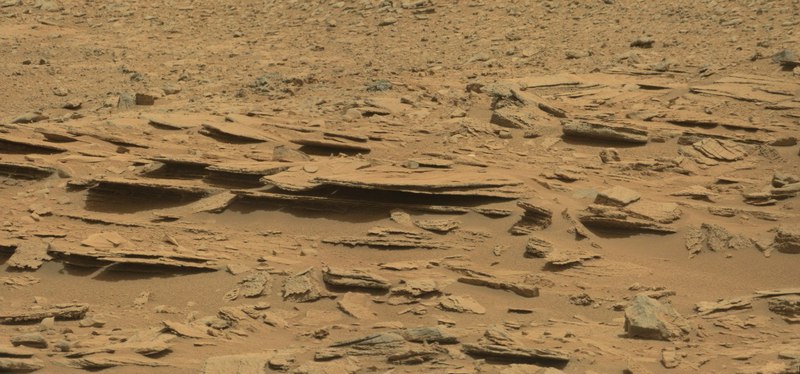
Curiosity has already passed this interesting outcrop. I assumed that he would be stuck with him for a month, it was not for nothing that the name was chosen in honor of the American paleontologist. But then geologists beckoned the bottom of Yellowknifle Bay, so they did not linger.

But now they intend to understand more in this multi-page geological book. The main question that Curiosity will try to find an answer for is the reason for the appearance of layers. Did the wind bring them or was it water? Earlier, geologists have already reported that the size of the grains of which these rocks are composed is too large to be transported by wind, i.e. implied the work of water. Now they want to study in more detail and make the final verdict. Whether they will be drilling there yet is not reported, they will probably also decide on the spot.
In the meantime, Curiosity looked into an old John Clein well.
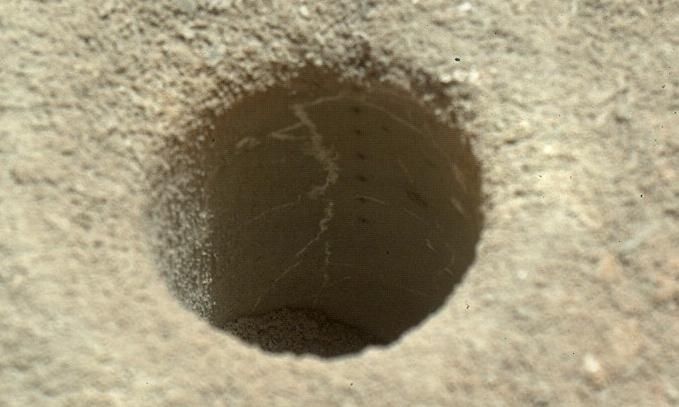
At the end of March, he shot her with a ChemCam spectrometer laser, points on the borehole wall - from him.
This was done to understand if there are any layers in the breed. But besides the usual cracks already filled with plaster, I could not find anything. There are no analysis results yet, but there are no layers visible in the photographs, and there are white streaks everywhere and it has already been determined that this is gypsum.
Then the rover moved 2.5 meters slightly to the side. A new target for the drill called Cumberland.
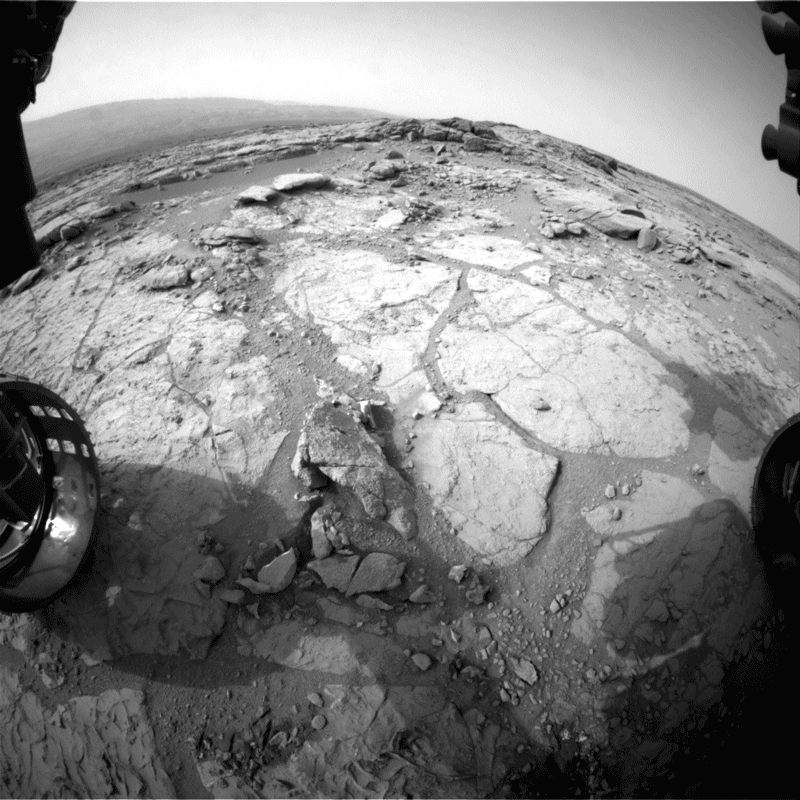
First, it was traditionally shot with a laser, then it was processed with the alpha-rays of the APXS spectrometer, and then it was thrust into a drill.
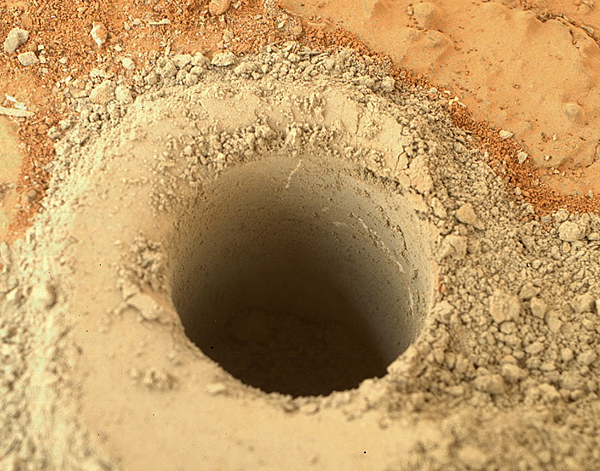
Test wells have not been done - driven up to the stop. ( process gif-animation 8 mb )
On the same day, the sample was sieved and the next day it was loaded into the internal devices: SAM and CheMin.
However, judging by the external signs, there should be no differences compared to the previous analysis from the place of John Clein.
I suppose that immediately after the analysis is complete, Curiosity will hit the road. In moving forward and new discoveries, not only fans around the world, but also NASA themselves have yearned.
PS Meanwhile, Opportunity finished exploring Matievich Hill, found clay and now went on a two-kilometer voyage to a new target - Solander Point Hill.

For several days in a row, Opportunity has been doing a few tens of meters a day, and only a kilometer separates it from the absolute record of mileage on space bodies outside the Earth. Lunokhod-2, forty years retaining the boundary of 37 km, will soon have to give first place.

Curiosity barely recovered from damage to memory elements and survived a “brain transplant”, so its creators particularly worried about it. Veteran Opportunity experienced such “holidays” repeatedly, so for his team this has become almost a chore. At the same time, a few days before the end of the "vacation", Opportunity caught the mistake and went into standby mode, and immediately after the restoration of communication on Curiosity started a software update. But now both in the ranks and all in the work.
Back in March, before the solar overlap, an important event in the scientific world took place: the 44th Conference of the Moon and Planets. Although the subject covered almost the entire solar system, the whole event was held under the sign of Curiosity and Mars. More than 60 research teams dedicated their reports to the conference to the Curiosity results. Those who wish to plunge into the advanced front of planetary science offer to look into the conference theses .
At this event, scientists not only shared the scientific materials obtained by the rovers, but also revealed their future plans. Actually, Curiosity is planned to be returned to the route that it had been planned for before landing. But in the light of the new data that he discovered despite the early scientific program, his path now needs a more convincing basis.
')
I will remind a little. When Curiosity was landed on Mars, it was assumed that it would rush to Mount Eolid (Sharpe) because smectites were found at its foot from the satellite — clays that indicate a favorable climate that could contribute to the vital activity of the organisms. True, when landing, the rover slightly deviated from the intended route, so he found an intermediate target called Glenelg.

In Glenelg did not expect to find clays or evidence of the habitability of Mars, geologists were interested in a curious site, where three types of surface converged in one place: ancient craters; smooth cracked; and washed up by the stream from the mountains. Curiosity began to study them in reverse order. In the late fall of 2012, the first handful of the rock was properly analyzed and came to the conclusion of its volcanic origin. Then, in the winter of 2013, I reached the lowland part called Yellowknifle Bay, which from the satellite looked like a cracked bottom of a dried lake. And, not surprisingly, this turned out to be the bottom of the lake. Moreover, on this day, the long-awaited clay was unexpectedly found.
So, in just about 200 Martian days, Curiosity achieved the near-most important goal of its expedition. The truth of life is not found. Not even a hint. The scientific team is still braving, justifying itself, saying that we need to look elsewhere, and now chooses where to send the rover. A guide is supposed to follow the water.
Let's return to the conference materials.
Although scientists from the University of Pristnosky

( blue dot - Curiosity )
The first reservoir occupied almost the entire area of the crater and was about 650 meters deep.
The second was smaller - only 170, but left behind a wide dune field, fifty kilometers south-west of the current position of Curiosity.
The third reservoir was quite shallow, about 20 meters deep and occupied exactly the very Yellowknifle Bay, where the rover is now located. The lake left behind a plot with high thermal inertia covered with large but shallow cracks.
It is not yet clear whether it was three great floods, or it was a process of shallowing of one reservoir, which for a long time was delayed three times at certain levels. The mountain that rose above these lakes arose at the time of the impact of the asteroid, when a crater arose, but the wind did make it much wider, piling on mountains of dust and sand. There are certainly no traces of life there, but the layers can tell the details of the climate history of Mars.
The average level of 170 meters is very attracting the attention of the head of the Curiosity scientific team, John Grotzinger. One of his reports at the conference was devoted to interesting elements of the relief on the slopes of Eolida.

With a rich imagination and an excess of optimism, it can be assumed that NASA has gathered to take up excavations of the ruins of a Martian city. But in reality, all the more prosaic.
Such structures American geologists called boxwork. On Mars, they are found on both centimeter and multimeter scale. The reasons for their occurrence may be different, but in fact boxwork is “opposite cracks”. In the case of the Gale crater, the bottom surface of a drying lake once cracked, and the cracks were filled with cementitious rock. Subsequently, under the action of erosion, the base collapsed and was moved by the wind, and the crack filler turned out to be more resistant to external influences.
Grotzinger believes that such obvious evidence of water activity on Mars should be studied, and this goal is planned as the final, in the main program of Curiosity. Than the mars rover will be engaged further, does not reveal yet. I think they themselves do not yet know. Much will depend on the results he gathers in his path, and what scientific resources he will have by that time.
But we know the nearest goal, which attracts geologists - Shaler.

Curiosity has already passed this interesting outcrop. I assumed that he would be stuck with him for a month, it was not for nothing that the name was chosen in honor of the American paleontologist. But then geologists beckoned the bottom of Yellowknifle Bay, so they did not linger.

But now they intend to understand more in this multi-page geological book. The main question that Curiosity will try to find an answer for is the reason for the appearance of layers. Did the wind bring them or was it water? Earlier, geologists have already reported that the size of the grains of which these rocks are composed is too large to be transported by wind, i.e. implied the work of water. Now they want to study in more detail and make the final verdict. Whether they will be drilling there yet is not reported, they will probably also decide on the spot.
In the meantime, Curiosity looked into an old John Clein well.

At the end of March, he shot her with a ChemCam spectrometer laser, points on the borehole wall - from him.
This was done to understand if there are any layers in the breed. But besides the usual cracks already filled with plaster, I could not find anything. There are no analysis results yet, but there are no layers visible in the photographs, and there are white streaks everywhere and it has already been determined that this is gypsum.
Then the rover moved 2.5 meters slightly to the side. A new target for the drill called Cumberland.

First, it was traditionally shot with a laser, then it was processed with the alpha-rays of the APXS spectrometer, and then it was thrust into a drill.

Test wells have not been done - driven up to the stop. ( process gif-animation 8 mb )
On the same day, the sample was sieved and the next day it was loaded into the internal devices: SAM and CheMin.
However, judging by the external signs, there should be no differences compared to the previous analysis from the place of John Clein.
I suppose that immediately after the analysis is complete, Curiosity will hit the road. In moving forward and new discoveries, not only fans around the world, but also NASA themselves have yearned.
PS Meanwhile, Opportunity finished exploring Matievich Hill, found clay and now went on a two-kilometer voyage to a new target - Solander Point Hill.

For several days in a row, Opportunity has been doing a few tens of meters a day, and only a kilometer separates it from the absolute record of mileage on space bodies outside the Earth. Lunokhod-2, forty years retaining the boundary of 37 km, will soon have to give first place.
Source: https://habr.com/ru/post/180387/
All Articles